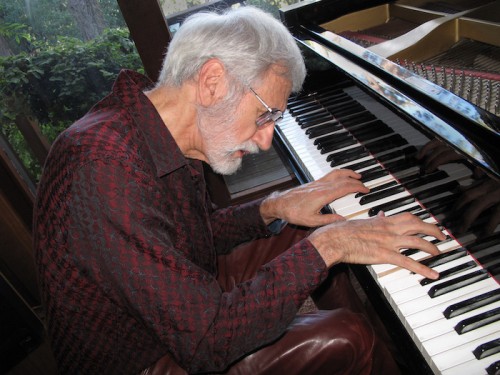Apr 2, 2024 12:59 PM
Saxophonist, Sonic Explorer Casey Benjamin Dies at 45
Casey Benjamin, the alto saxophonist, vocalist, keyboardist and producer who stamped his distinctive sounds on the…

Gravitating toward intimacy, pianist Denny Zeitlin rarely has worked with horns since his 1963 debut with flutist Jeremy Steig.
(Photo: Josephine Zeitlin)Miles Davis’ legacy is complex and elusive. Like Picasso, the trumpeter encompasses multitudes, mirrors infinite possibilities, and exudes duende and mystery.
Pianist Denny Zeitlin’s solo tribute to Davis, recorded live at Piedmont Piano Company in Oakland, explores the chameleonic leader’s writing—and songs by others he embraced—with a curator’s discerning ear as it finds dark humor and revels in daring reharmonizations.
“I never met Miles,” said Zeitlin, who began playing jazz at 12 in 1950 and gigged through college in his hometown of Chicago. “But he impressed me early by constantly stretching, searching, evolving.”
Shapeshifter Davis—a magnet to adoring fans and a magus to young talent—was quick to write, collaborate and borrow his material. So, Remembering Miles (Sunnyside) offers a robust set of chord-draped tunes, cherry-picked from Davis’ expansive career to portray him as mysterious, idiosyncratic and ever-inventive.
“Solar” shades into partly cloudy brooding, and jaunty “Dear Old Stockholm” runs melodic variations with bone-rattling glissandi. Music box twinkles open “Flamenco Sketches” into free modal dreaming, and on Benny Golson’s “Stablemates,” a ruminating bass trips the dark fantastic. Two takes on “Milestones” are offered, too; triads scamper like mice, then an amiable Brubeckian stroller jumps onto the uneven bars. And “Circle,” a shapely waltz, unveils broad harmonic vistas.
Selecting tunes from such a sprawling career, though, took reflection and inspiration: “I went through my Miles records and discographies with a dual goal to honor the spirit of the original and put my personal stamp on it. I ask, ‘Can I take this tune to a new place, surprise myself and the listener?’”
Zeitlin had chosen quite a different tack than on an earlier tribute to Wayne Shorter. Wowed by the reedist’s 1959 leader debut on Vee-Jay at the age of 26, a collegiate-aged Zeitlin was “captivated by the originality of his sound and concept both as performer and composer.” 2016’s Early Wayne (Explorations Of Classic Wayne Shorter Compositions) favored limber, jubilant pieces from Shorter’s fertile mid-’60s period—“JuJu,” “ESP,” “Infant Eyes,” “Nefertiti,” “Teru”—and reached a bright, regal outcome.
At 81, and amid a half-century dual career as medical professional and pianist, Zeitlin, too, finds himself still-evolving and inquisitive. Pursuing the “cross-pollination” between psychiatry and music, he takes “a long view of musical geology, the underlying structure of the terrain.”
Gravitating toward intimacy, he’s rarely worked with horns since his 1963 debut with flutist Jeremy Steig. His robust trio with Buster Williams and Matt Wilson, founded in 2001, put in a week at Manhattan’s Mezzrow this May. And head-to-head duos—previously with bassists Charlie Haden and David Friesen—continue today in electro-acoustic free improvisations with drummer George Marsh.
Reimagining Davis’ poppier mid-’80s favorites—Cyndi Lauper’s “Time After Time” and Marcus Miller’s “Tomaas”—Zeitlin strove to capture the feel of seething deep-funk, a role he freely pursues with Marsh.
“Ever since I was a little boy, I had this dream of somehow being an orchestra,” Zeitlin recalled. “Wouldn’t it be wonderful to have all these colors at your fingertips? Now, technology [lets you] realize it in real-time without having to layer track upon track. It’s all there.”
Zeitlin shines bright on his own, handily achieving that orchestral scope. About the Piedmont space, he enthused, “I can’t imagine a better venue for presenting solo piano. Acoustics are near perfect: It’s not a big-box nightclub, plagued by the standing wave phenomenon or annoying hotspots. The vibe is great, the pianos perfect and the audience attentive.” DB

Benjamin possessed a fluid, round sound on the alto saxophone, and he was often most recognizable by the layers of electronic effects that he put onto the instrument.
Apr 2, 2024 12:59 PM
Casey Benjamin, the alto saxophonist, vocalist, keyboardist and producer who stamped his distinctive sounds on the…

“He’s constructing intelligent musical sentences that connect seamlessly, which is the most important part of linear playing,” Charles McPherson said of alto saxophonist Sonny Red.
Feb 27, 2024 1:40 PM
“I might not have felt this way 30 to 40 years ago, but I’ve reached a point where I can hear value in what people…

Albert “Tootie” Heath (1935–2024) followed in the tradition of drummer Kenny Clarke, his idol.
Apr 5, 2024 10:28 AM
Albert “Tootie” Heath, a drummer of impeccable taste and time who was the youngest of three jazz-legend brothers…

“Both of us are quite grounded in the craft, the tradition and the harmonic sense,” Rosenwinkel said of his experience playing with Allen. “Yet I felt we shared something mystical as well.”
Mar 12, 2024 11:42 AM
“There are a few musicians you hear where, as somebody once said, the molecules in the room change. Geri was one of…

Henry Threadgill performs with Zooid at Big Ears in Knoxville, Tennessee.
Apr 9, 2024 11:30 AM
Big Ears, the annual four-day music celebration that first took place in 2009 in Knoxville, Tennessee, could well be…